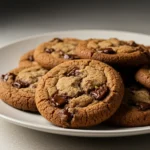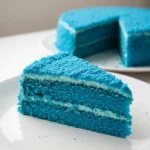Chocolate chip cookies are a timeless treat, beloved by many for their perfect balance of sweetness and texture.
Whether you’re aiming for a soft and chewy bite or a crisp edge, mastering the art of the perfect chocolate chip cookie is both a science and an art. This guide delves into the secrets behind creating the best chocolate chip cookies, drawing insights from top recipes and baking experts.
Table of Contents
Table of Contents
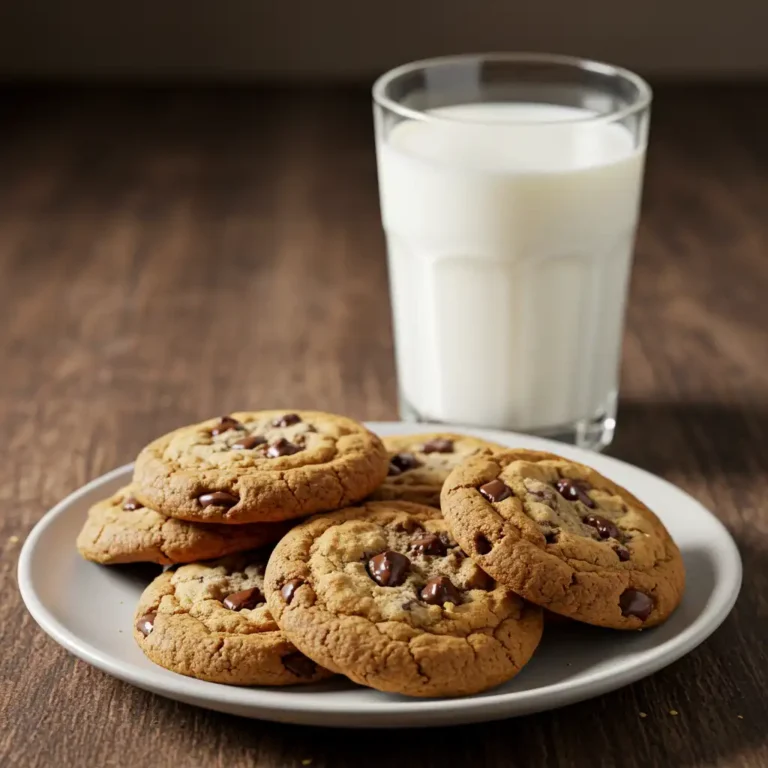
Best Chocolate Chip Cookies
Soft, chewy, and loaded with gooey chocolate, these are the best chocolate chip cookies you’ll ever bake. With crispy edges and a soft center, this classic cookie recipe is easy to follow and delivers bakery-style results right at home.
- Total Time: 27 minutes
- Yield: 24 cookies 1x
Ingredients
1 cup (226g) unsalted butter, softened
1 cup (200g) granulated sugar
1 cup (215g) packed light brown sugar
2 large eggs
2 tsp pure vanilla extract
3 cups (360g) all-purpose flour
1 tsp baking soda
½ tsp baking powder
1 tsp salt
2 cups (340g) semi-sweet chocolate chips
Optional: 1 tsp espresso powder (for rich flavor)
Instructions
Preheat & Prep
Preheat oven to 350°F (175°C). Line two baking sheets with parchment paper.Cream Butter & Sugars
In a large bowl, beat the softened butter, granulated sugar, and brown sugar together until creamy and fluffy (about 2–3 minutes).Add Eggs & Vanilla
Mix in the eggs, one at a time, followed by the vanilla extract. Beat until combined.Combine Dry Ingredients
In a separate bowl, whisk together flour, baking soda, baking powder, and salt.Mix Wet & Dry
Gradually add the dry ingredients into the wet mixture. Mix until a soft dough forms.Fold in Chocolate Chips
Stir in chocolate chips (and optional espresso powder) until evenly distributed.Scoop & Chill
Scoop dough into 2 tbsp portions and place on baking sheet. Chill for 15–30 minutes for thicker cookies.Bake
Bake for 10–12 minutes or until the edges are golden and the centers are just set.Cool & Enjoy
Let cookies rest on the baking sheet for 5 minutes before transferring to a wire rack.
Notes
For ultra-chewy cookies, use bread flour instead of all-purpose flour.
Chill dough longer (up to 24 hours) for deeper flavor and thicker cookies.
Add flaky sea salt on top before baking for a gourmet touch.
Store in an airtight container for up to 5 days or freeze for up to 3 months.
- Prep Time: 15 minutes
- Cook Time: 12 minutes
- Category: Dessert
- Method: Baking
- Cuisine: American
Nutrition
- Serving Size: 1 cookie
- Calories: 215
- Sugar: 18g
- Sodium: 140mg
- Fat: 11g
- Saturated Fat: 6g
- Unsaturated Fat: 4g
- Trans Fat: 0g
- Carbohydrates: 28g
- Fiber: 1g
- Protein: 2.5g
- Cholesterol: 30mg
The Science Behind Perfect Chocolate Chip Cookies
Understanding Ingredient Functions
Crafting the best chocolate chip cookies isn’t just about throwing ingredients into a bowl—it’s about understanding the science behind each one. When you know what every component does, you can confidently tweak and perfect your recipe.
Flour acts as the base and provides structure. The amount and type of flour you use will greatly influence how soft, chewy, or firm your cookies turn out.
Butter gives richness and softness. For those aiming to bake the best chocolate chip cookies, choosing between melted, creamed, or browned butter can significantly affect the final texture.
Sugar controls sweetness, color, and spread. Brown sugar adds moisture and chewiness, while white sugar gives crisp edges—a critical factor in nailing that bakery-style finish.
Eggs bind the ingredients and add volume. The yolk adds tenderness while egg whites create a light and airy texture.
Baking soda and baking powder are leavening agents that cause cookies to puff and brown. Using the right amount is key to getting thick and golden cookies.
Salt and vanilla extract may seem small, but they pack a flavor punch. Salt balances sweetness while vanilla enhances the deep, warm tones of chocolate.
Chocolate chips? They’re the showstopper. Using semi-sweet chips or even chopped chocolate bars can help elevate your cookie game to best chocolate chip cookies level.
The Role of Temperature and Mixing Techniques
One thing all top recipes for the best chocolate chip cookies agree on? Temperature control. It’s a make-or-break factor in achieving the right texture and structure.
- Room-temperature butter and eggs mix more evenly and prevent clumps, ensuring your cookie dough is smooth and consistent.
- Chilling the dough for at least 30 minutes improves flavor and limits spread during baking, making your cookies thicker and more flavorful.
- Don’t overmix. Too much mixing activates gluten in the flour, making cookies tougher than they should be.
Another trick: the creaming method—beating butter with sugar until fluffy—incorporates air for that perfectly tender bite you expect from the best chocolate chip cookies.
Choosing the Right Ingredients for the Best Chocolate Chip Cookies
High-Quality Chocolate: Chips vs. Chunks
When you’re aiming to make the best chocolate chip cookies, the kind of chocolate you use matters—a lot. Chocolate chips are convenient, but switching to high-quality chunks or chopped chocolate bars can take your cookies to the next level.
- Semi-sweet chips are classic and balanced, offering rich flavor without overwhelming sweetness.
- Dark chocolate adds a luxurious intensity and pairs well with sweet dough.
- Milk chocolate is a sweeter option that works well for kids’ cookies or dessert platters.
- Chopped chocolate bars melt into uneven, gooey pockets that give bakery-style results.
Pro Tip: Look for chocolate with at least 60% cocoa for a deeper, more satisfying flavor.
The Butter Debate: Salted vs. Unsalted
When baking the best chocolate chip cookies, always reach for unsalted butter. It gives you full control over your cookie’s salt content, especially since different brands of salted butter can vary.
- Unsalted butter allows precision in flavor balancing.
- Salted butter can be unpredictable in savory-to-sweet ratio.
Moreover, using room temperature or browned butter adds different textures and nutty undertones. Browned butter, in particular, gives your cookies a caramelized depth that’s hard to beat.
Flour Matters: All-Purpose vs. Specialty
For the majority of best chocolate chip cookies recipes, all-purpose flour is the gold standard. It offers the perfect protein content to create structure without making cookies too dense.
But here’s where you can play:
- Bread flour creates chewier cookies thanks to higher protein.
- Pastry flour results in a softer, more tender texture.
- Gluten-free blends are available for dietary needs, but may require xanthan gum for structure.
Sugar Types and Their Impact
Want soft and chewy? Brown sugar is your best friend. Prefer a crisp edge? Add more granulated white sugar. The balance between these sugars affects moisture, flavor, and texture.
| Sugar Type | Texture Result | Flavor Profile |
|---|---|---|
| Brown sugar | Moist and chewy | Rich, caramel-like |
| White sugar | Crispy edges | Clean, neutral sweetness |
| Coconut sugar | Dense, earthy | Slightly nutty |
Eggs and Extracts: Subtle but Essential
Eggs act as a binder and moisture agent. Use large eggs at room temperature to prevent a curdled batter. Want a richer cookie? Use one whole egg plus an extra yolk.
For that unmistakable cookie aroma, pure vanilla extract is a must. Avoid imitation—real vanilla adds depth and complexity that shines in every bite.
Mixing Methods That Matter for the Perfect Cookie Texture
Why Creaming Butter and Sugar Is a Game-Changer
The foundation of every irresistible cookie lies in the way you mix your ingredients—especially the butter and sugar. The creaming method, where butter and sugar are beaten together until light and fluffy, introduces air into the dough. This not only helps your cookies rise but also creates a tender and soft interior.
- Under-creamed dough can lead to dense, flat cookies.
- Over-creaming can cause cookies to spread too much.
For best results:
- Use room-temperature butter (not melted).
- Mix on medium speed for 2–3 minutes until pale and fluffy.
Pro Tip: Always scrape down the sides of the bowl to ensure even mixing.
The Importance of Ingredient Order
Mixing isn’t just about combining everything in one bowl—there’s a science to the order.
- Cream butter and sugars first.
- Add eggs one at a time for proper emulsification.
- Stir in vanilla extract.
- Fold in flour mixture gently to avoid overworking the dough.
- Add chocolate last so it stays chunky and intact.
This order allows each ingredient to play its part without compromising texture or taste.
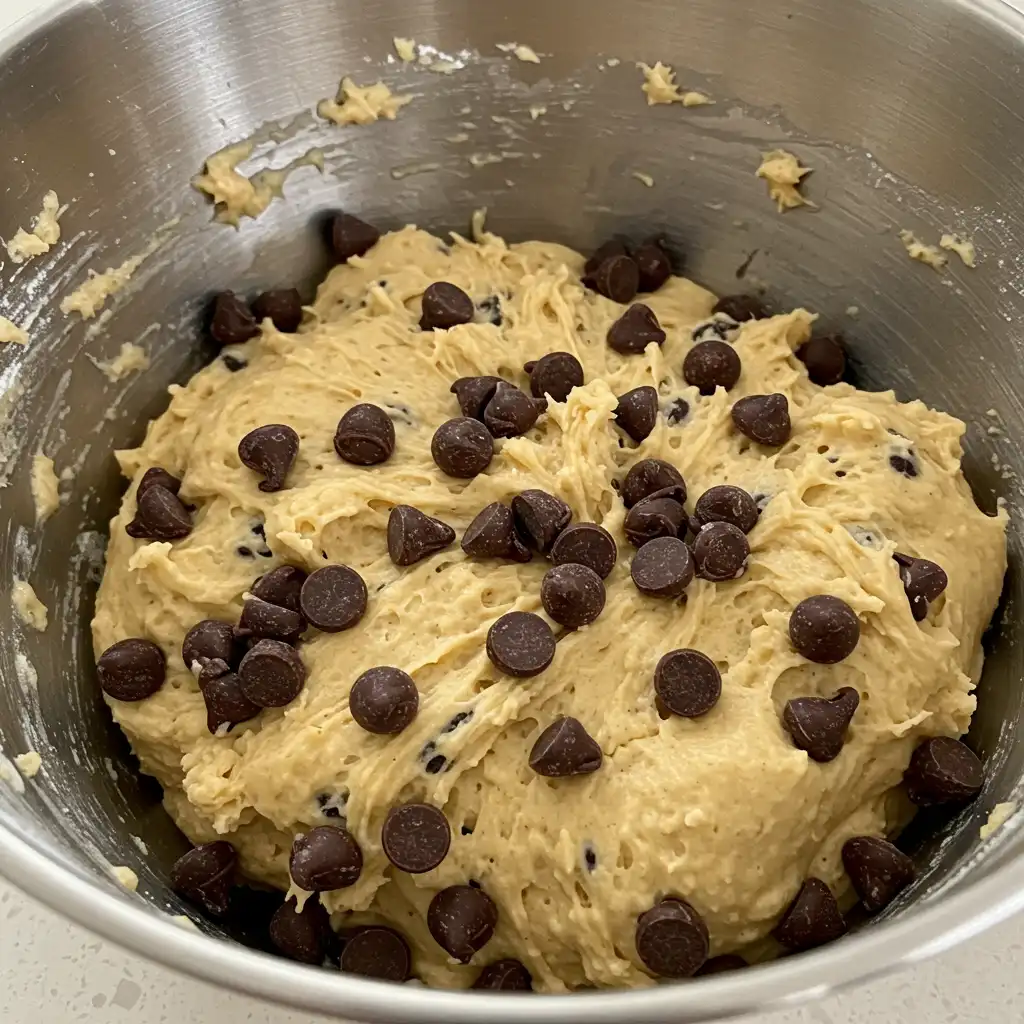
Don’t Overmix the Dough
Once flour is added, gluten starts to develop. Overmixing at this stage can make your cookies tough and bread-like. To avoid this:
- Mix until just combined.
- Stop as soon as there are no visible streaks of flour.
- Hand-fold chocolate chunks or chips with a spatula for better control.
Chill Time: Why Patience Pays Off
Letting your dough rest in the fridge for 24–48 hours allows the flour to hydrate and the flavors to meld. This results in cookies that are more caramelized, chewy, and rich.
| Chill Time | Result |
|---|---|
| No chilling | Soft, spread-out cookies |
| 30 mins–1 hr | Slightly thicker, improved texture |
| 24–48 hours | Intensely flavorful, perfect texture |
Bonus: Chilling also gives you a better structure, making it easier to scoop uniform dough balls.
Baking Techniques That Guarantee Results
Preheating Matters More Than You Think
One of the most overlooked yet critical steps in cookie baking is preheating the oven. Skipping or rushing this step can sabotage your entire batch. Why? Because when you put cookie dough into an oven that isn’t fully heated, it can cause:
- Uneven baking
- Excessive spreading
- Dry or underbaked centers
Always allow your oven to reach a consistent 350°F (177°C) before placing the cookie tray inside. For the best chocolate chip cookies, even heat is non-negotiable.
Tip: Use an oven thermometer to double-check the internal temperature if your oven tends to be inconsistent.
Choosing the Right Bakeware
The tools you use can affect everything from texture to browning. Here’s how to choose like a pro:
- Light-colored metal baking sheets: These help prevent over-browning and ensure even heat distribution.
- Avoid glass or dark nonstick pans: They tend to overbake the bottoms.
- Use parchment paper or silicone baking mats: These prevent sticking and help cookies hold their shape.
| Bakeware Type | Result |
|---|---|
| Light metal tray | Even baking, soft texture |
| Dark metal or glass | Overbrowned or burnt bottoms |
| Parchment/silicone mat | Clean release, rounder cookies |
Spacing Dough for Uniform Cookies
Even the best cookie dough can fall short if spacing is wrong. When placing dough balls on the tray:
- Leave at least 2 inches between each cookie.
- Use a cookie scoop for uniformity.
- Avoid overcrowding this leads to steam buildup, making cookies spread too much and cook unevenly.
For bakery-style cookies, bake in small batches and space generously.
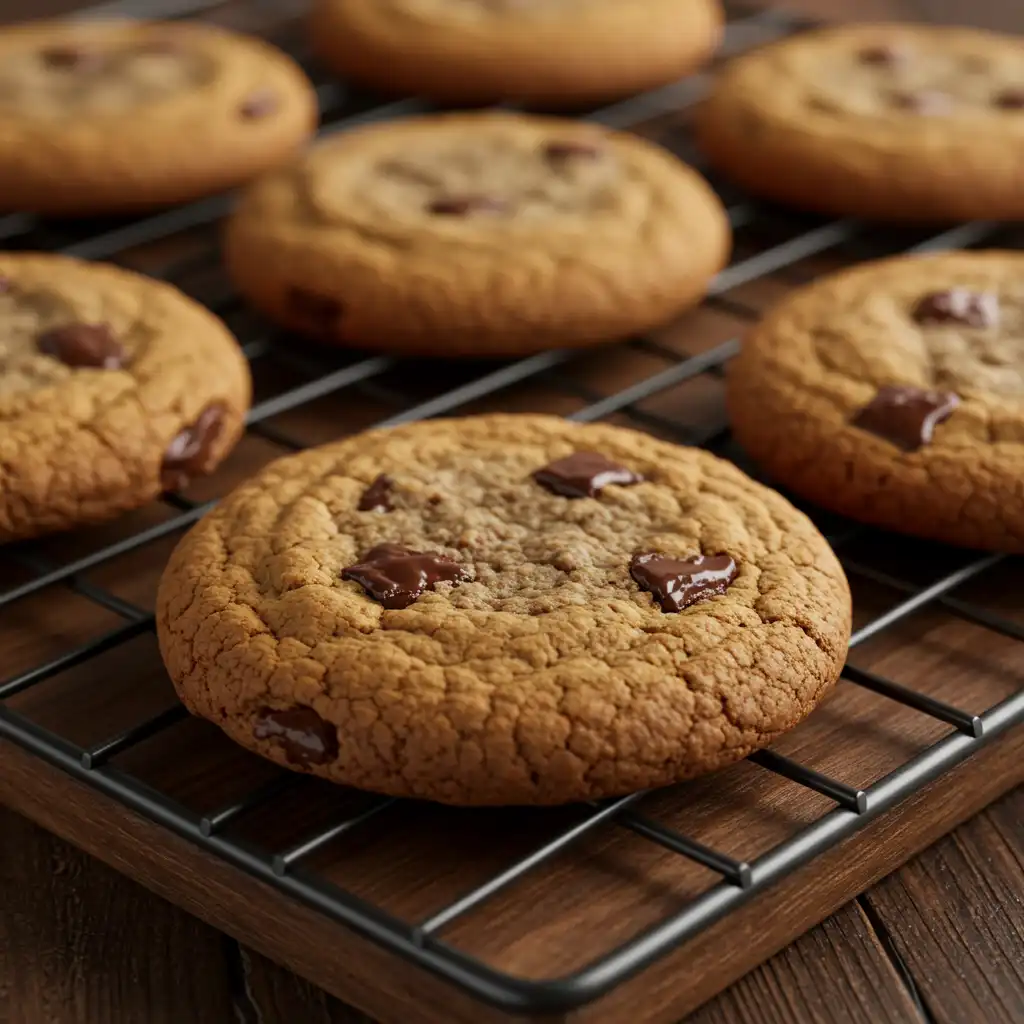
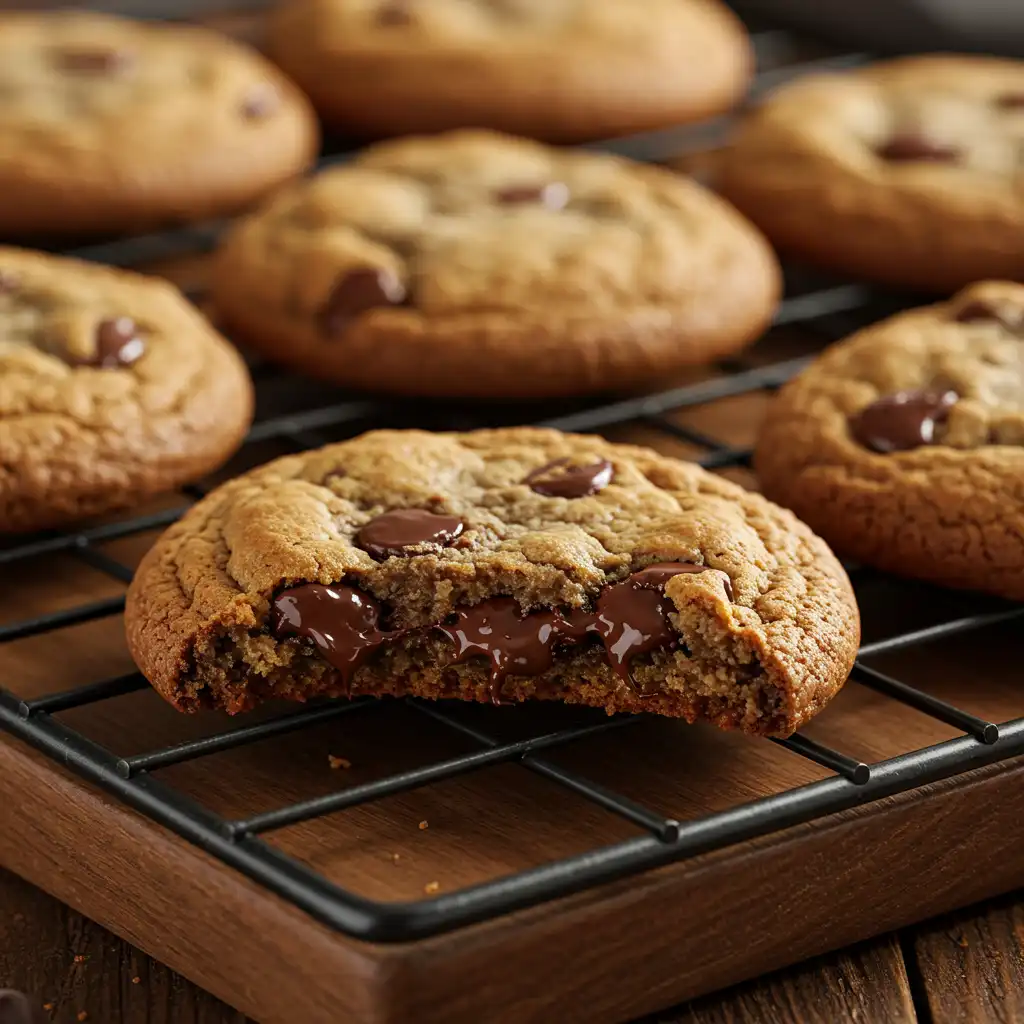
Mid-Bake Rotation and Bake Time Control
Most home ovens have hot spots, which means cookies on one side might bake faster than the other. Here’s how to counter that:
- Rotate the baking sheet halfway through (usually around the 6–7-minute mark).
- Total bake time for chocolate chip cookies: 10–12 minutes.
For chewy centers and crisp edges, take them out when the centers still look slightly underbaked they’ll continue cooking on the sheet for a few minutes after removal.
The Chocolate Factor – Chips vs. Chunks
Choosing the Right Chocolate for the Best Results
When it comes to the best chocolate chip cookies, the type of chocolate you use can make or break the flavor. Whether you prefer classic chocolate chips or indulgent chocolate chunks, both can create the perfect cookie, but there are key differences to consider.
- Chocolate Chips: These are smaller and designed to hold their shape during baking, which can give your cookies a more uniform look.
- Chocolate Chunks: Larger pieces of chocolate that melt more easily, creating gooey pockets of chocolate in each bite. They tend to give a more rustic, bakery-style look.
Dark vs. Milk Chocolate: Which Is Best for Your Cookies?
The choice between dark chocolate and milk chocolate comes down to personal preference, but each offers distinct benefits:
- Dark chocolate has a more robust, slightly bitter flavor that balances the sweetness of the dough.
- Milk chocolate is smoother and sweeter, providing a more indulgent, creamy texture.
For a balanced taste in best chocolate chip cookies, consider mixing both types of chocolate. This will give you the perfect blend of rich cocoa flavor and creamy sweetness.
Pro Tip: Use high-quality chocolate with a cocoa percentage of 60% or higher for a deep, sophisticated flavor profile. Avoid using overly sweet or waxy chocolate, as it can affect both the taste and texture.
The Secret to Melt-In-Your-Mouth Texture
To achieve that signature melt-in-your-mouth texture for your chocolate chip cookies, try these tips:
- Chop the chocolate: Instead of using pre-made chips, chop a high-quality chocolate bar into irregular chunks. This adds texture and creates pockets of chocolate that melt perfectly.
- Use chocolate with a higher fat content: Higher fat percentages will result in richer, more satisfying cookies. It also helps with the soft and chewy texture we all love.
Mixing It Up: Different Chocolate Varieties
If you’re feeling adventurous, why not experiment with unique chocolate varieties? Consider using:
- White chocolate chips for a sweet contrast.
- Butterscotch chips for a rich, caramelized flavor.
- Peanut butter chips to add a nutty twist.
Mixing different types of chocolate or even including nuts can elevate your best chocolate chip cookies into something extraordinary.
Cooling and Serving Tips for the Perfect Cookie Experience
The Importance of Cooling Your Cookies
Once your best chocolate chip cookies are out of the oven, patience is key. Many bakers are tempted to dive right in, but cooling your cookies properly can make all the difference in achieving the perfect texture.
- Let them sit on the baking sheet: Allow your cookies to cool for 5-10 minutes on the hot baking sheet. This allows them to firm up a bit and prevents them from falling apart when you transfer them.
- Transfer to a wire rack: Once they’ve cooled slightly, move your cookies to a wire rack to allow air to circulate around them. This helps them cool evenly and prevents them from becoming soggy on the bottom.
Pro Tip: For chewy, soft cookies, transfer them while they are still a bit soft. The residual heat will help them firm up without becoming too crunchy.
Serving Your Best Chocolate Chip Cookies
The way you serve your best chocolate chip cookies can elevate the experience. Here are some tips to make your cookies the star of any gathering:
- Serve warm: There’s nothing like enjoying a warm, gooey chocolate chip cookie right out of the oven. If you’re serving them later, heat them up in the microwave for 10-15 seconds to restore that fresh-baked feel.
- Pair with milk: A classic choice—serve your cookies with a tall glass of cold milk for a nostalgic, comforting treat.
- Add a sprinkle of sea salt: For an elevated flavor experience, sprinkle a tiny bit of flaky sea salt on top just before serving. The salt enhances the chocolate and brings out deeper flavors.
Storing Your Cookies for Freshness
To keep your best chocolate chip cookies fresh, proper storage is key:
- Room temperature storage: Place your cookies in an airtight container. They’ll stay fresh for up to 1 week.
- Freezing cookies: For longer storage, you can freeze your cookies for up to 6 months. Place cookies in a single layer on a baking sheet, freeze until solid, then store in an airtight bag.
Pro Tip: To thaw frozen cookies, let them sit at room temperature for about 10 minutes, or pop them in the microwave for a few seconds.
Common Mistakes to Avoid for Perfect Cookies
1. Overmixing the Dough
One of the most common mistakes when making best chocolate chip cookies is overmixing the dough. While it’s tempting to keep stirring until everything is perfectly combined, overmixing can lead to tough cookies. The key to soft, chewy cookies is to mix just until the dry ingredients are incorporated.
Pro Tip: Stop mixing when you no longer see flour streaks in the dough. This will help prevent overdeveloping the gluten, which can make your cookies dense and chewy in a bad way.
2. Not Chilling the Dough
Chilling your cookie dough is one of the best ways to prevent flat, overly spread-out cookies. While this step may seem like an extra chore, it makes a world of difference. Chilling the dough helps:
- Solidify the fat (butter), which slows down the spreading during baking.
- Enhance the flavors, allowing the dough to rest and the ingredients to meld together.
- Improve the texture, giving your cookies a thicker, chewier consistency.
For best chocolate chip cookies, chill the dough for at least 30 minutes, though overnight is even better for maximum flavor.
3. Baking on the Wrong Temperature
Every oven is different, and one of the most frequent mistakes bakers make is not adjusting for their oven’s temperature. Baking cookies at the wrong temperature can result in undercooked centers or overly crispy edges.
- Too hot: Cookies can burn on the edges while remaining raw in the middle.
- Too cool: The dough may spread too much, making the cookies too thin and crispy.
Pro Tip: Always preheat your oven and check the internal temperature with an oven thermometer to ensure even baking.
4. Using the Wrong Type of Sugar
The type of sugar you use can influence both the texture and flavor of your cookies. Here’s how:
- Granulated sugar makes for a crispier, lighter cookie.
- Brown sugar adds moisture and creates a chewy texture due to its molasses content.
For best chocolate chip cookies, a mix of both sugars gives the perfect balance of texture and flavor.
5. Underbaking or Overbaking
The bake time is crucial to getting the right texture. Underbaking can result in doughy cookies, while overbaking can dry them out. Here’s the trick:
- Underbake for chewy cookies with soft centers.
- Overbake slightly for crispier cookies.
Pro Tip: For perfect cookies, take them out when the edges are golden brown, but the centers are still slightly soft. They’ll firm up as they cool.
Storage and Freezing Tips for Long-Lasting Freshness
Proper Storage to Keep Cookies Fresh
Storing your best chocolate chip cookies properly ensures they stay delicious for as long as possible. If you’ve baked a batch of cookies and want to keep them fresh, consider the following tips:
- Airtight Containers: Store your cookies in an airtight container to lock in moisture and prevent them from becoming stale. This is especially important for soft, chewy cookies, as they can dry out quickly.
- Room Temperature Storage: At room temperature, your cookies will stay fresh for up to 1 week. For longer-lasting freshness, be sure to check the container every few days to ensure the cookies haven’t lost their softness.
- Separate Layers with Parchment Paper: If you’re storing multiple layers of cookies, place a sheet of parchment paper between each layer to prevent them from sticking together.
Pro Tip: If you’ve added a lot of chocolate chips to your dough, you may notice some chocolate oozing out. Let the cookies cool completely before storing them to prevent any chocolate from sticking to the container lid.
Freezing Your Cookies for Long-Term Storage
Want to keep your best chocolate chip cookies for months? Freezing them is a great option!
- Freeze the Dough: Scoop dough onto a baking sheet and freeze the individual cookie portions until firm. Once frozen, transfer the dough balls to a freezer bag and store them for up to 6 months. This allows you to bake fresh cookies whenever the craving hits.
- Freeze Baked Cookies: You can also freeze baked cookies. Place them in a single layer on a baking sheet and freeze until firm. Then, transfer the cookies to a freezer-safe container or bag for storage.
- Reheat Frozen Cookies: To reheat your frozen cookies, simply place them on a baking sheet and bake at 300°F (150°C) for about 10 minutes. This will revive their soft and chewy texture.
Pro Tip: Freezing cookie dough is a fantastic way to prepare in advance, especially if you plan on hosting a gathering or need cookies on short notice.
The Best Way to Thaw Frozen Cookies
When you’re ready to enjoy your frozen cookies, here’s how to thaw them for the best results:
- Room Temperature Thawing: Simply remove the cookies from the freezer and let them sit at room temperature for 10-15 minutes. This ensures they thaw evenly without becoming soggy.
- Microwave Thawing: For a quicker method, place the cookies on a microwave-safe plate and heat them for 10-15 seconds. This will soften the chocolate and make them taste fresh-baked.
Pro Tip: If you want the cookies to have that warm, just-out-of-the-oven experience, microwave them for a few seconds to melt the chocolate once thawed.
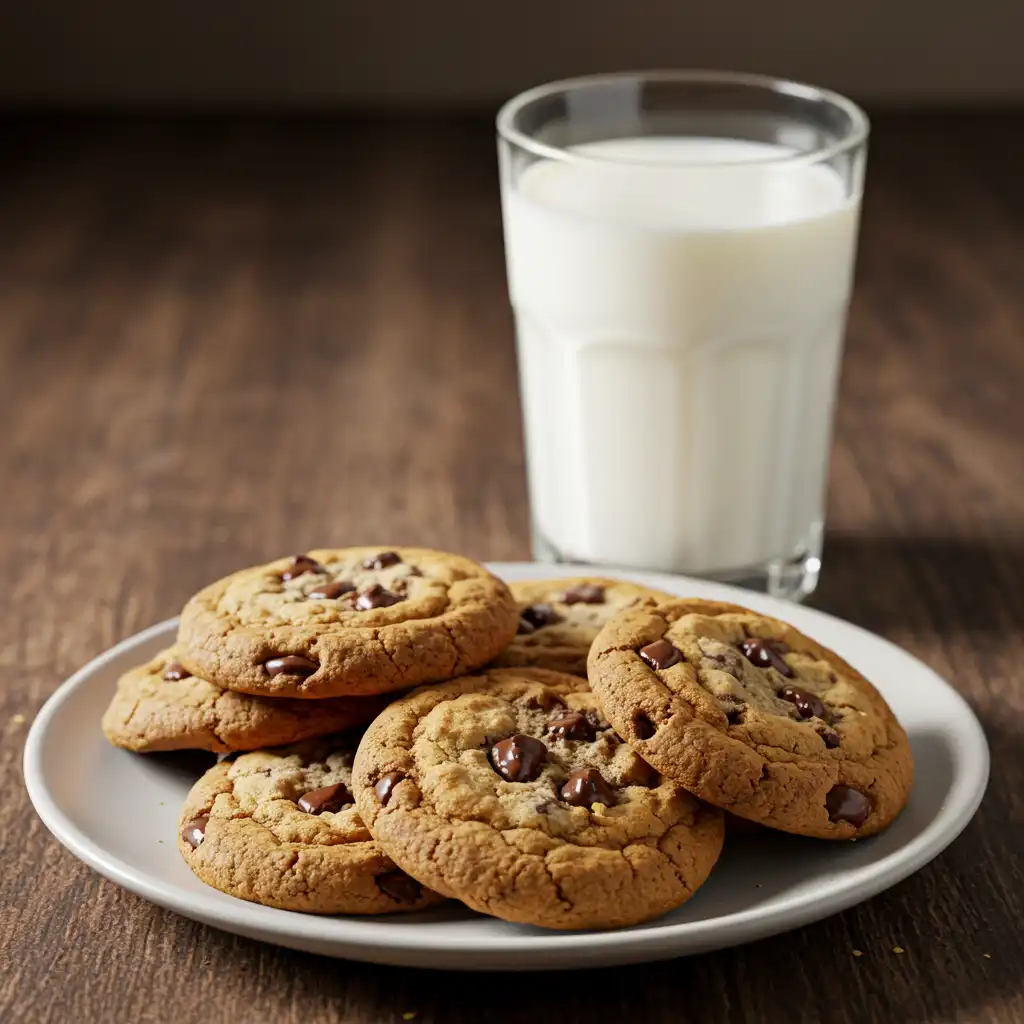
Conclusion and Final Thoughts on the Best Chocolate Chip Cookies
Final Thoughts on Baking the Best Chocolate Chip Cookies
Baking the best chocolate chip cookies isn’t just about following a recipe — it’s about bringing care, love, and attention to detail in every step. From selecting high-quality chocolate chips to mastering the perfect dough consistency, every element plays a crucial role in ensuring your cookies turn out as delicious as possible.
Remember, baking cookies is both a science and an art. Don’t be afraid to tweak the recipe and experiment with different ingredients to find what suits your taste best. Whether you prefer chewy, gooey cookies or slightly crispy edges, there’s no one-size-fits-all approach, and that’s part of the fun of baking!
FAQs
What is the secret to the best cookies?
The secret to the best chocolate chip cookies lies in using high-quality ingredients, such as premium chocolate chips, and ensuring the dough is not overworked. Also, chilling the dough for at least 30 minutes helps the cookies maintain a thicker, chewier texture. Don’t skip the butter — it gives the cookies a rich, melt-in-your-mouth flavor.
What is the secret to chocolate chip cookies?
For the best chocolate chip cookies, the balance of ingredients and technique is key. The use of both brown and white sugar gives a perfect combination of chewiness and crispness. Additionally, baking at the right temperature, usually around 350°F (175°C), and taking care not to overbake them are essential to achieving the ideal cookie texture.
What makes cookies soft and chewy instead of crispy?
To make cookies soft and chewy, use more brown sugar than white sugar in your dough. Brown sugar retains moisture, creating a chewy texture. Also, slightly underbake your cookies, removing them from the oven when the edges are golden but the centers are still soft. This helps to retain moisture and prevent them from becoming too crispy.
How do you make bakery-style cookies at home?
To make bakery-style cookies at home, aim for a larger cookie size and use high-quality ingredients like artisan chocolate and fresh butter. Allow the dough to chill for at least an hour before baking, and make sure to space the cookies well on the baking sheet to ensure they don’t spread too much. For that perfect golden edge, slightly underbake the cookies and let them cool on the sheet.
What is the secret ingredient that makes cookies taste amazing?
While there’s no single “secret ingredient,” many bakers swear by a dash of vanilla extract or a sprinkle of sea salt on top of their cookies for an added burst of flavor. Additionally, chilling the dough before baking and using high-quality chocolate chips can elevate the taste of your cookies significantly.
Why do my chocolate chip cookies come out flat?
Flat cookies often result from too much butter or not enough flour in the dough. Ensure your butter is at room temperature, not melted. Also, be mindful of how long you mix the dough. Overmixing can lead to too much air, causing the cookies to spread too thin. Try chilling the dough before baking to help maintain their shape.
How do professionals get their cookies perfectly round and thick?
Professional bakers often use a cookie scoop to portion out uniform dough balls, ensuring even size and thickness. They also carefully space the cookies on the baking sheet to prevent them from spreading too much. Some also slightly press the dough balls with a spatula to help them bake evenly, ensuring a perfect round shape.
What’s the best way to store cookies so they stay fresh longer?
To keep your cookies fresh for longer, store them in an airtight container at room temperature. For added freshness, place a slice of bread in the container — the bread will help absorb moisture and keep the cookies from drying out. If you want to store them for a longer period, freeze the cookies or dough, and they will stay fresh for several months.
Did You Try Our Recipe?
There are no reviews yet. Be the first one to write one.



